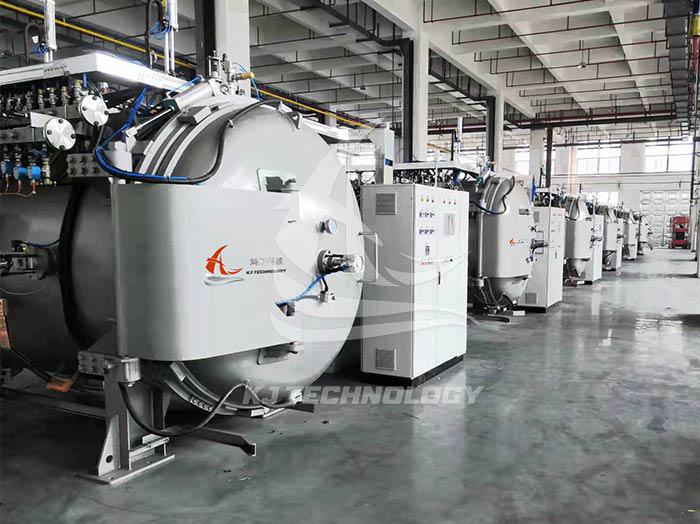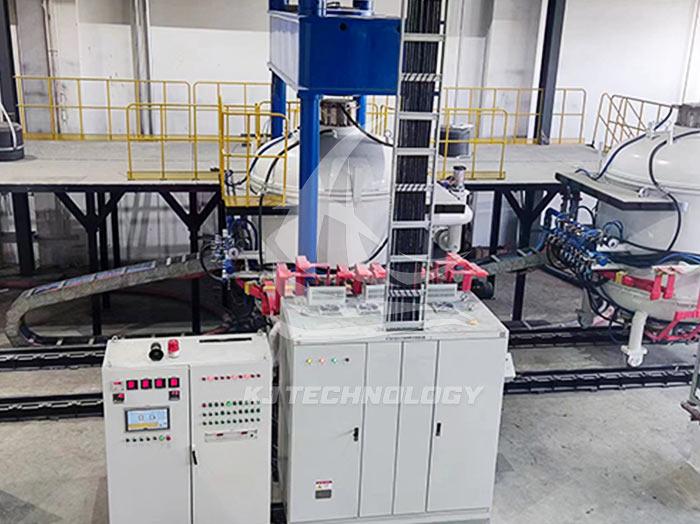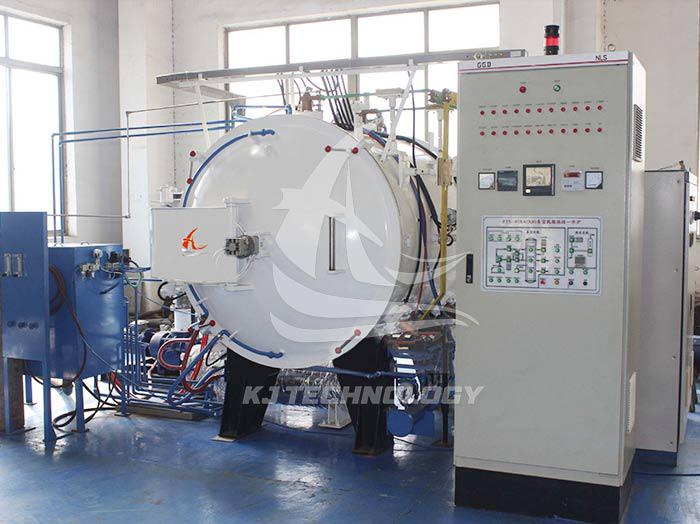Precautions for operating aluminum brazing vacuum furnace
 07-03-2025 Author: KJ technology
07-03-2025 Author: KJ technology
The operation of aluminum brazing vacuum furnace must strictly follow the specifications to ensure process quality, equipment safety, and personnel protection. The following are key precautions during the operation process:
1. Preparation before operation
Workpiece pre-processing
Cleaning: Thoroughly remove oil, moisture, oxide film, and impurities from the surface of the workpiece to avoid contaminating the furnace environment or affecting the quality of brazing.
Assembly: Assemble the workpiece according to the process requirements, ensuring that the brazing material is evenly distributed and the gap meets the design standards (usually 0.05-0.2mm).
Drying: The cleaned workpiece should be thoroughly dried to prevent water from evaporating in a vacuum environment and causing pressure fluctuations.
Equipment inspection
Vacuum system: Check the oil level and sealing of mechanical pumps, Roots pumps, and diffusion pumps to ensure that the vacuum degree meets the standard (maximum vacuum degree ≤ 3 × 10 ⁻ ³ Pa).
Heating system: Confirm that the heating elements (such as resistance wires and graphite heaters) are not damaged, and that the temperature sensors (thermocouples) are accurately positioned and calibrated effectively.
Cooling system: Check if the nitrogen pressure and water cooling flow rate are normal to prevent insufficient cooling from causing workpiece oxidation or equipment damage.
Safety device: Verify whether the functions of over temperature alarm, over voltage protection, emergency stop, etc. are sensitive and reliable.
Environmental requirements
Keep the area around the furnace clean, free of flammable and explosive materials, and well ventilated to avoid the accumulation of high-temperature gases.
Operators are required to wear protective clothing, gloves, and goggles to prevent burns or splashes.
2. Standard operating procedures
Furnace installation and fixation
Place the workpiece steadily on the fixture inside the furnace, avoiding tilting or colliding with the furnace wall.
Large or complex workpieces need to be fixed with specialized fixtures to prevent deformation or displacement during the heating process.
Vacuum pumping stage
Initial pumping: After closing the furnace door, start the mechanical pump and Roots pump in sequence to pump the pressure inside the furnace to below 10Pa.
High vacuum stage: Turn on the diffusion pump and continue pumping to the maximum vacuum degree (≤ 3 × 10 ⁻ ³ Pa), and maintain it for 10-15 minutes to completely remove the oxide film.
matters needing attention:
During the vacuum pumping process, closely observe the pressure changes. If the pressure rises, there may be air leakage, and the machine needs to be stopped for inspection.
Avoid prolonged vacuuming at low temperatures to prevent condensation on the surface of the workpiece.
Heating and brazing stage
Heating control: Heat up in sections according to the process curve, and the heating rate is usually controlled at 5-10 ℃/min to avoid cracking of the workpiece caused by thermal stress.
Insulation stage: After reaching the brazing temperature (such as 580-615 ℃ for aluminum alloy), hold for 10-30 minutes to ensure that the brazing material is fully melted and fills the gap.
Key parameters:
Temperature uniformity: The temperature difference inside the furnace should be controlled within ± 3 ℃, which can be optimized by zone heating or circulating fans.
Vacuum degree maintenance: During the brazing process, the vacuum degree must not be lower than 1 × 10 ⁻ ² Pa, otherwise heating must be paused and vacuum pumping must be resumed.
cooling stage
Natural cooling: After brazing is completed, turn off the heating power and allow the workpiece to slowly cool down with the furnace to below 400 ℃.
Forced cooling: If the cycle needs to be shortened, high-purity nitrogen gas (purity ≥ 99.999%) can be filled for rapid cooling, but the inflation rate needs to be controlled to prevent deformation of the workpiece.
Timing of release: The workpiece can only be released from the furnace when the temperature drops below 150 ℃ to avoid high-temperature oxidation or burns.
3. Safety protection measures
Vacuum system safety
Before vacuuming, ensure that the furnace door is well sealed to prevent air leakage and abnormal pressure.
When shutting down, first close the diffusion pump valve, and then stop the Roots pump and mechanical pump to avoid oil return and contamination of the furnace chamber.
Heating system safety
Strictly prohibit over temperature operation and set up dual level over temperature alarms (such as a first level alarm of 650 ℃ and a second level alarm of 700 ℃).
When the heating element is damaged, it needs to be stopped immediately for replacement, and it is forbidden to operate it with defects.
Cooling system safety
Forced cooling is prohibited when the nitrogen pressure is insufficient to prevent oxidation of the workpiece.
Water cooling system failure (such as low flow rate and high water temperature) should trigger an emergency stop to avoid heating element burnout.
Emergency Management
Power off: Immediately close all valves, use the residual heat of the furnace to maintain a vacuum state, restore power supply, and follow the program to vacuum and heat again.
Leakage: Quickly shut down and release pressure, check the sealing components or welding joints of the furnace body, repair and retest the vacuum degree.
Workpiece stuck: It is forbidden to forcibly remove it. It needs to be cooled to room temperature first and then disassembled with special tools.
4. Maintenance and upkeep
Routine maintenance
Clean the aluminum shavings and solder residue in the furnace every shift to prevent contamination of subsequent workpieces.
Check if the thermocouple protective sleeve is damaged and replace it promptly to avoid temperature measurement errors.
regular maintenance
Weekly: Check the oil level and color of the vacuum pump, and replace it if it deteriorates; Clean the diffusion pump oil oxidation products.
Monthly: Test the ultimate vacuum degree and pressure rise rate (after closing all valves, a pressure rise of ≤ 1Pa/min is considered qualified).
Every six months: Disassemble the furnace and inspect the aging of the insulation screen and heating elements, and replace them if necessary.
Record and Trace
Establish an operation log to record key parameters such as temperature curve, vacuum degree, cooling time, etc. for each furnace run.
Save the quality inspection report of the workpiece (such as X-ray inspection, sealing test) for easy problem tracing.








